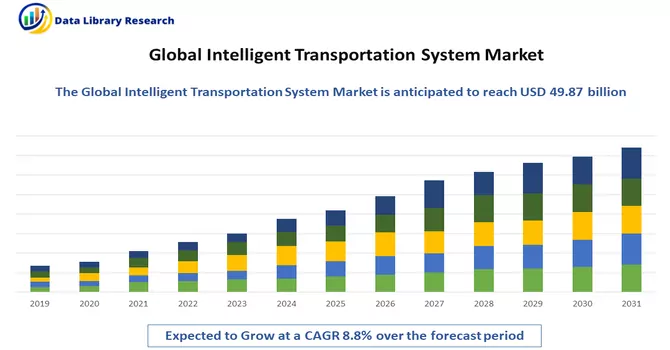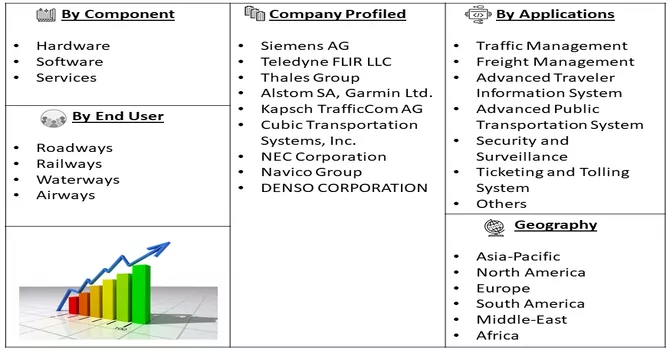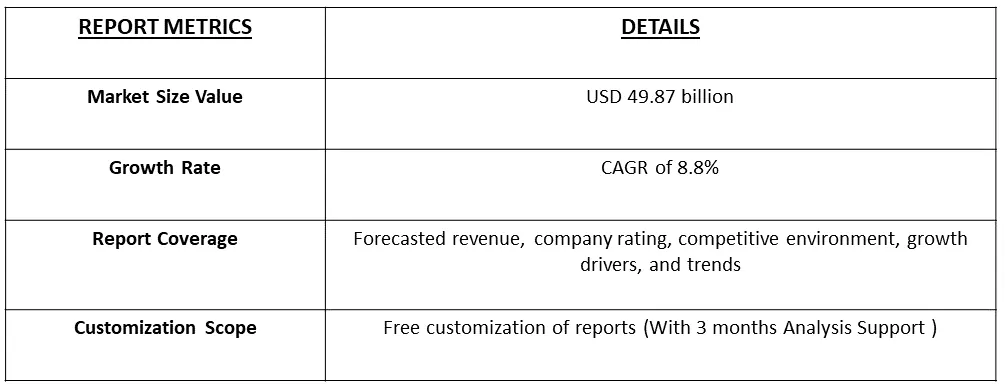The estimated size of the global intelligent transportation system (ITS) market reached USD 49.87 billion in 2022, and it is projected to experience a compound annual growth rate (CAGR) of 8.8% from 2023 to 2031.

Get Complete Analysis Of The Report - Download Free Sample PDF
An Intelligent Transportation System (ITS) refers to a comprehensive and interconnected set of technologies, applications, and communication systems designed to enhance the efficiency, safety, and overall performance of transportation networks. ITS leverages advanced information and communication technologies to intelligently manage and optimize various aspects of transportation, including traffic flow, vehicle mobility, and traveller safety.
The market's growth is attributed to the rising demand for solutions related to traffic control and smart vehicles, the enhanced safety and monitoring capabilities offered by technologies like License Plate Recognition (LPRs) and modern cameras, and the emergence of smart cities. The Intelligent Transportation System plays a pivotal role in providing solutions for traffic management, contributing to improved road safety, traffic flow, and overall mobility. This has created a positive outlook for the market. The onset of the COVID-19 pandemic in 2020 posed challenges, leading to a slowdown in implementation projects and new sales and installations of ITS. However, the market rebounded significantly from mid-2021 onwards.
The key driver for the market's growth is the increasing investment by governments of various countries in infrastructure development activities as part of efforts to recover from the economic impact of the pandemic. The demand for intelligent transportation solutions has seen a resurgence as countries focus on enhancing their transportation networks and embracing smart technologies. Thus, the global ITS market has experienced notable growth, fueled by the demand for traffic management solutions, the integration of smart technologies in vehicles, advancements in surveillance technologies, and the broader trend towards establishing smart cities. While the initial phase of the COVID-19 pandemic disrupted the market, the subsequent recovery and renewed focus on infrastructure development have propelled the ITS market towards significant growth over the forecast period.
Market Segmentation: The Intelligent Transportation System (ITS) Market is Segmented by Component (Hardware, Software, and Services), Application (Traffic Management, Freight Management, Advanced Traveller Information System, Advanced Public Transportation System, Security and Surveillance, Ticketing and Tolling System, Others), End User (Roadways, Railways, Waterways, and Airways) and Geography (North America, Europe, Asia Pacific, and Rest of the world). In addition, the report offers market size and forecast for the recreational vehicle market in value (USD billion) for all the above segments.

For Detailed Market Segmentation - Download Free Sample PDF
The proliferation of connected and autonomous vehicles is influencing ITS trends. Integration of ITS with CAVs facilitates communication between vehicles and infrastructure, leading to more coordinated traffic management, reduced congestion, and improved overall safety. The development of smart cities and the emphasis on urban mobility solutions are driving the adoption of ITS. Intelligent transportation systems play a key role in optimizing traffic flow, managing parking, and enhancing public transportation services in the context of urbanization. These trends collectively shape the evolution of the global ITS market, highlighting the ongoing efforts to create intelligent, connected, and sustainable transportation ecosystems.
Market Drivers:
Rise in Traffic Jams Around the World
The rise in traffic jams around the world has become a significant challenge for urban and metropolitan areas, impacting both the efficiency of transportation systems and the quality of life for residents. The surge in urbanization, population growth, and increased vehicle ownership contribute to the growing congestion on roadways. In addressing this issue, the implementation of Intelligent Transportation Systems (ITS) emerges as a crucial and transformative solution. Rapid urbanization and population growth result in higher demand for transportation services. Cities become hubs of economic activity, leading to increased vehicular traffic and, subsequently, congestion. Thus, the rise in traffic jams worldwide necessitates innovative solutions, and Intelligent Transportation Systems emerge as a key strategy. By leveraging technology, real-time data, and adaptive approaches, ITS plays a pivotal role in addressing and mitigating traffic congestion, contributing to more efficient, sustainable, and resilient transportation systems in urban environments.
Increased Investment in Railways
The increased investment in railways and the growing focus on intelligent transportation solutions are significant trends shaping the modernization and efficiency of transportation networks. This trend reflects a broader effort to address challenges such as traffic congestion, environmental sustainability, and the need for seamless and interconnected mobility solutions. Governments and transportation authorities globally are recognizing the environmental benefits and efficiency of rail transport. Investments in railways align with sustainability goals, as trains generally have a lower carbon footprint compared to traditional road transportation. Thus, due to the above-mentioned factors, the market is expected to witness significant growth over the forecast period.
Market Restraints:
High Initial Cost of Implementation and Interoperability Challenges
The implementation of intelligent transportation systems involves significant upfront costs, including the installation of infrastructure, sensors, and communication technologies. These high initial expenses can pose a barrier to adoption, particularly for smaller municipalities or regions with limited budgets. The lack of standardized protocols and interoperability among different intelligent transportation solutions can hinder seamless integration. Incompatibility issues may arise when attempting to connect diverse systems, limiting the effectiveness of a holistic transportation network. Thus, these factors are expected to witness significant growth over the forecast period.
The pandemic led to disruptions in global supply chains, affecting the production and availability of components and hardware essential for intelligent transportation systems. Delays in manufacturing and distribution impacted project timelines and deployments. Many planned ITS projects faced delays or were postponed as governments and organizations redirected resources and attention to pandemic response efforts. Budgetary constraints and uncertainties about the economic outlook contributed to project postponements. The pandemic highlighted the need for resilient transportation systems. Governments and organizations started incorporating resilience planning into their ITS strategies, considering factors such as adaptability to unforeseen disruptions and the ability to maintain critical operations. Thus, with the ongoing challenges and transitions to a post-pandemic environment, the intelligent transportation system market is likely to witness continued adjustments, innovations, and adaptations to the evolving needs of the transportation industry and society at large.
Segmental Analysis:
Software Segment is Expected to Witness Significant Growth Over the Forecast Period
The Software and Intelligent Transportation System (ITS) market is a dynamic and evolving sector that plays a crucial role in modernizing and optimizing transportation networks. This market encompasses a wide range of software solutions and applications designed to enhance the efficiency, safety, and sustainability of transportation systems. ADAS software is integral to improving vehicle safety by providing features such as lane departure warnings, adaptive cruise control, and collision avoidance. These systems enhance the capabilities of vehicles and contribute to a safer and more intelligent transportation environment. Smart parking software is designed to streamline the parking process, providing real-time information on parking space availability and optimizing parking management. This contributes to reduced traffic congestion and improved urban mobility. Thus, the software and intelligent transportation System market is characterized by a diverse range of solutions that leverage technology to enhance the safety, efficiency, and sustainability of transportation networks. The continuous evolution of software applications within the ITS sector is driving innovation and shaping the future of intelligent and connected transportation.
Traffic Management Segment is Expected to Witness Significant Growth Over the Forecast Period
Traffic management software is a cornerstone of ITS, facilitating the monitoring and control of traffic flow. These solutions leverage real-time data, sensors, and algorithms to optimize signal timings, manage congestion, and improve overall traffic efficiency. The Traffic Management and Intelligent Transportation System (ITS) market represent pivotal components in the modernization and optimization of transportation networks, contributing to enhanced safety, efficiency, and sustainability. ITS integrates advanced technologies to collect, analyze, and disseminate information to improve the functionality of transportation networks. It encompasses both hardware and software solutions. Thus, the Traffic Management and ITS markets are interconnected, with a shared goal of creating intelligent, efficient, and sustainable transportation ecosystems. The integration of advanced technologies continues to shape the future of these markets, fostering innovation in traffic management strategies and contributing to the evolution of smart and connected transportation systems.
Airways Segment is Expected to Witness Significant Growth Over the Forecast Period
The integration of Airways and Intelligent Transportation Systems (ITS) represents a significant paradigm shift in the optimization of air traffic management and ground transportation networks. The Airways market primarily focuses on air traffic management and control within airspace. It involves the coordination of aircraft movements, air traffic control (ATC), and navigation systems to ensure safe and efficient air travel. Intelligent Transportation Systems encompass advanced technologies that facilitate the seamless integration and coordination of various transportation modes, including air, road, and rail. In the context of airways, ITS contributes to ground transportation connectivity and overall transportation optimization. ITS components integrated into the airways domain include smart traffic management, real-time data analytics, communication systems, and advanced navigation solutions. Thus, the integration of Airways and Intelligent Transportation Systems marks a transformative approach to creating a more interconnected and efficient transportation network. As technology continues to evolve, the seamless coordination between air and ground transportation systems will play a pivotal role in shaping the future of integrated and intelligent mobility.
North America Region is Expected to Witness Significant Growth Over the Forecast Period
The North American Intelligent Transportation System (ITS) market is a dynamic and rapidly evolving sector that plays a pivotal role in advancing transportation infrastructure and optimizing mobility. The ITS market in North America involves the deployment and integration of advanced technologies to enhance the safety, efficiency, and sustainability of transportation systems across the continent.
The North American ITS market is expected to witness continued growth with the increasing deployment of autonomous and connected vehicles. These technologies will contribute to safer and more efficient transportation systems. Thus, the ITS market in North America is characterized by a commitment to innovation, collaboration, and the integration of advanced technologies to address the evolving challenges of transportation. The region is poised to remain at the forefront of intelligent transportation advancements, shaping the future of mobility and connectivity. Thus, the region is expected to witness significant growth over the forecast period.

Get Complete Analysis Of The Report - Download Free Sample PDF
Major corporations are implementing a range of strategic initiatives including acquisitions, agreements, expansions, partnerships, contracts, and product launches to fortify their market standing. These diverse strategies are pivotal in enhancing their competitive positions, fostering growth, and solidifying their presence in the market. Through such endeavours, these leading companies aim to stay ahead in the dynamic business landscape, capitalize on emerging opportunities, and continually meet the evolving demands of their respective industries. Some of the key market players are:
Recent Development:
1) In October 2023, Alstom SA forged a partnership with FLXO Robotics to pioneer technology aimed at mitigating wildlife collision accidents. The collaborative effort seeks to employ cutting-edge image analytics and AI algorithms to identify animals in the vicinity. The technology's primary objective is to emit a customized repellent noise, effectively deterring animals and thereby reducing the risk of collisions.
2) In November 2023, Siemens AG completed the acquisition of HMH, s.r.o, a prominent manufacturer of the MIREL train protection system deployed in Slovakia, Czech Republic, Hungary, and Poland. This strategic acquisition enhances Siemens Mobility's capabilities, enabling the provision of a comprehensive train protection portfolio covering Eastern European rail corridors. While maintaining its base in Bratislava, Slovakia, HMH will be seamlessly integrated into Siemens Mobility's Rail Infrastructure business unit. The acquisition reinforces Siemens Mobility's standing as a leading provider of rail infrastructure solutions in the European market.
Q1. What was the Intelligent Transportation System Market size in 2023?
As per Data Library Research the global intelligent transportation system (ITS) market reached USD 49.87 billion in 2022.
Q2. At what CAGR is the intelligent transportation system market projected to grow within the forecast period?
Intelligent Transportation System Market is projected to experience a compound annual growth rate (CAGR) of 8.8% over the forecast period.
Q3. What segments are covered in the Intelligent Transportation System Market Report?
By Component, By Application, End-User and Geography are the segments covered in the Intelligent Transportation System Market Report.
Q4. What are the factors driving the Intelligent Transportation System Market ?
Key factors that are driving the growth include the Rise in Traffic Jams Around the World and Increased Investment in Railways.
Data Library Research are conducted by industry experts who offer insight on industry structure, market segmentations technology assessment and competitive landscape (CL), and penetration, as well as on emerging trends. Their analysis is based on primary interviews (~ 80%) and secondary research (~ 20%) as well as years of professional expertise in their respective industries. Adding to this, by analysing historical trends and current market positions, our analysts predict where the market will be headed for the next five years. Furthermore, the varying trends of segment & categories geographically presented are also studied and the estimated based on the primary & secondary research.
In this particular report from the supply side Data Library Research has conducted primary surveys (interviews) with the key level executives (VP, CEO’s, Marketing Director, Business Development Manager and SOFT) of the companies that active & prominent as well as the midsized organization
FIGURE 1: DLR RESEARH PROCESS

Extensive primary research was conducted to gain a deeper insight of the market and industry performance. The analysis is based on both primary and secondary research as well as years of professional expertise in the respective industries.
In addition to analysing current and historical trends, our analysts predict where the market is headed over the next five years.
It varies by segment for these categories geographically presented in the list of market tables. Speaking about this particular report we have conducted primary surveys (interviews) with the key level executives (VP, CEO’s, Marketing Director, Business Development Manager and many more) of the major players active in the market.
Secondary ResearchSecondary research was mainly used to collect and identify information useful for the extensive, technical, market-oriented, and Friend’s study of the Global Extra Neutral Alcohol. It was also used to obtain key information about major players, market classification and segmentation according to the industry trends, geographical markets, and developments related to the market and technology perspectives. For this study, analysts have gathered information from various credible sources, such as annual reports, sec filings, journals, white papers, SOFT presentations, and company web sites.
Market Size EstimationBoth, top-down and bottom-up approaches were used to estimate and validate the size of the Global market and to estimate the size of various other dependent submarkets in the overall Extra Neutral Alcohol. The key players in the market were identified through secondary research and their market contributions in the respective geographies were determined through primary and secondary research.
Forecast Model
